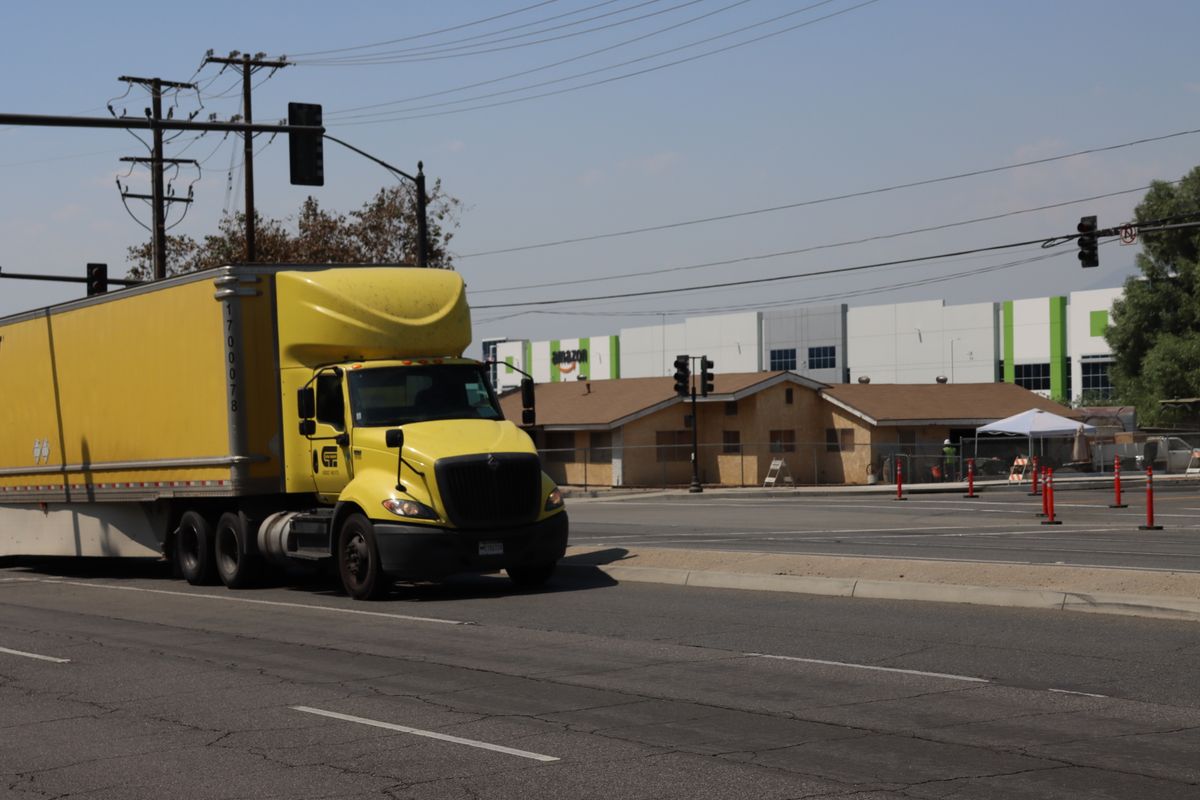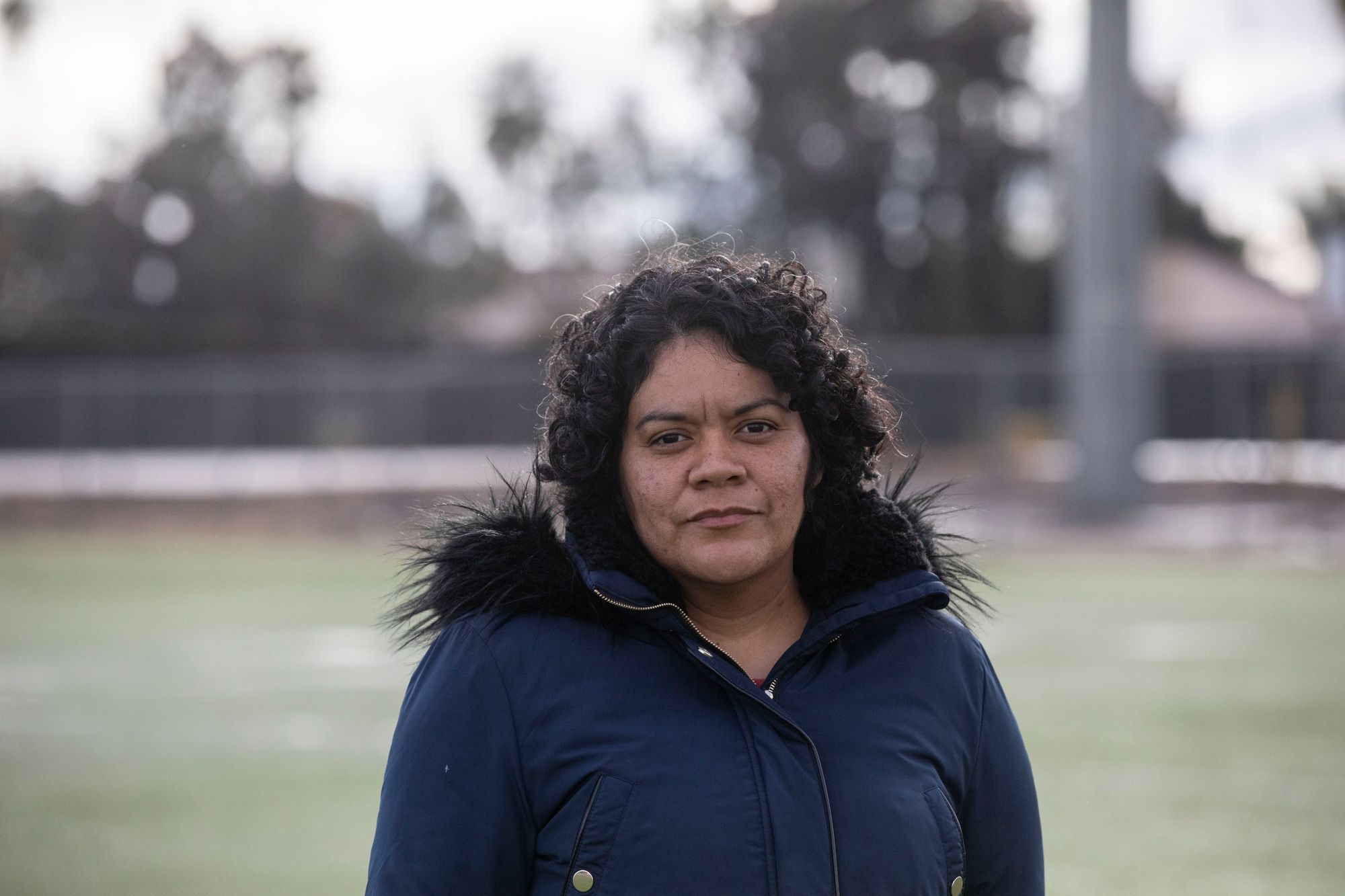State air resources board hearing for proposed electric truck fleet rule set for Thursday

A “Caravan for Clean Air” calls on the agency to consider a strong ‘Advanced Clean Fleet’ rule. Trucking groups call the rule “aspirational”
Community journalist and editor Yvette Vargas contributed to this story.
Right now, residents living near some of the state’s most polluted freight hubs are traveling to Sacramento to make testimony on Thursday in support of a truck fleet regulation that promises to eliminate emissions from the state’s most polluting vehicles.
The Advanced Clean Fleet rule proposed by the California Air Resources Board (CARB) will require public and private fleets to transition their delivery vans, garbage trucks and big rigs to electric by 2040. Also under the rule, every new vehicle added to drayage fleets – trucks transporting goods between port facilities, intermodal yards and warehouses – must be zero-emission starting in 2024.
Residents and clean air advocates believe the agency can push even stronger targets and regulatory approaches. They want CARB to move up the proposed 100% electric truck sales date from 2040 to 2036 and for the number of fleets under the ‘High Priority Fleet’ portion of the rule to be changed to 10 vehicles from 50. According to CARB, High priority fleets are entities that generate over $50 million in gross annual revenue or a fleet who owns, operates or controls 50 or more trucks under common ownership or individuals.
These changes could further protect workers and families, who are often subject to both exploitation and deadly pollution, explains People’s Collective for Environmental Justice (PC4EJ) Senior Policy Analyst Andrea Vidaurre.
This week, community members are going to Sacramento in a Caravan to tell @AirResources why we need 100% ZEV sales by 2036 & stronger regulations on trucks! #ACF #electrictrucksnow #ZeroEmissions
— People’s Collective for Environmental Justice (@PC4EJ) October 25, 2022
Follow along as we make stops throughout to meet with other frontline communities.
“We are not just advocating for environmental justice alongside community members, but we are also fighting to support independent truckers,” she said. “Most of the Inland Empire has someone involved in trucking and we know that their income and survival is attached to those trucks.”
An analysis done by CARB shows that the current proposal can reap $47 billion in net savings for California, while resulting in over 400,000 metric tons of nitrogen oxide and particulate matter pollution being reduced by 2050. An accelerated 2036 timeline for electric truck sales would add $10 billion more to that figure, while also decreasing emergency room visits and hospitalizations for cardiovascular and respiratory issues.
The ACF is the latest addition to a set of executive actions and policies that aim to transform California’s transportation sector to zero-emissions. A medium and heavy-duty truck complimentary policy – the Advanced Clean Truck rule – was passed in June 2020 to require manufacturers to begin producing electric trucks. Governor Gavin Newsom also issued an executive order in September 2020 to direct state agencies (including CARB) to phase out the sales of gasoline-powered cars and trucks by 2035.
“[ACF] is a very important rule, given that it is the first to be specifically aimed at diesel trucks from all uses,” Vidaurre said.
Still, many trucking associations and business groups continue to oppose the ACF rule due to concerns about the availability and feasibility of electric trucks. Public comment letters from freight corporations, trucking associations and fossil fuel associations claim the ACF rule would be detrimental to the goods movement industry because of insufficient battery range of electric trucks to deliver shipments on time. Others question whether a struggling grid can sustain higher demands for electricity that would come from a complete transition to electric vehicles. And most point to higher costs of electric trucks as a costly burden for smaller, independently owned fleets.
“This is really an aspirational rule – it's what they would like to happen,” said Joe Rajkovacz , spokesperson for the Western States Trucking Association. “They think if they mandate something it will happen. That’s not true. What they can do is really screw things up for goods movement in California. And that’s what most of us think is going to happen.”
Albert Vargas, an independent truck operator based in Fontana, is concerned that the ACF could add further burdens to his already depleted business. Vargas took a leap of faith nearly two decades ago by moving to the Inland Empire to start his small trucking business. Enforcement regulations set by CARB have led to higher maintenance costs, which Vargas says he’s had to undertake to avoid citations or tows. Now, his fleet is down to only two trucks.
“We’ve had no choice, but to comply,” he explains. “But it’s been frustrating.”
When learning about the ACF rule, Vargas expressed skepticism and hopes that CARB can be more reasonable and fair for small trucking operations. “There should be an option for small companies to make an appointment with CARB and have them diagnose situations case-by-case, instead of being cut-throat towards individuals who are trying and want to meet those requirements.”
Sam Appel with the Blue Green Alliance (BGA) believes the transition to electric trucks sets the foundation for the industry’s future. BGA, together with groups like the Teamsters and the California Labor Federation, argue that lowering the high-priority threshold from 50 to 10 trucks could help address truck driver misclassification, which has been compared to indentured servitude by labor organizers due to worker exploitation.
“This is one of the most exploitative industries in California to work in,” shared Appel. “Drivers in the independent contractor and drayage segments often make less than minimum wage and are forced to pay for their own trucks. CARB must structure this rule in such a way that the companies that are actually the profit-making entities and the controlling interests in the industry are forced to absorb the costs of the transition.”
CARB in an emailed statement said the ACF is “intended to help accelerate the zero-emission truck market.” When asked about the recommendations made by environmental justice and labor groups about the 2036 date and the high priority threshold, the agency said they “have taken a look at some of these options in [their] analysis.”

Ada Trujillo is a mother of three children who lives near the BSNF Intermodal Facility in San Bernardino. Her youngest son, Alan, 8, suffers from occasional nose bleeds and her husband has consistent issues with allergies. Alan attends Ramona Alessandro Elementary School across from BNSF, where studies have demonstrated that students there are likely to contract asthma due to diesel pollution exposure.
For Trujillo, the ACF rule presents a chance for CARB to put into motion suggestions about cleaning up freight pollution that she and many others have voiced to the agency and regional air regulator, South Coast Air Quality Management District (SCAQMD). Trujillo is a member of the AB 617 Steering Committee that addresses pollution issues in San Bernardino and Muscoy.
“We constantly have to adjust our daily lives to accommodate the industry,” she said. “It’s time for some accountability. [CARB] must begin to bring solutions to our communities now.”
